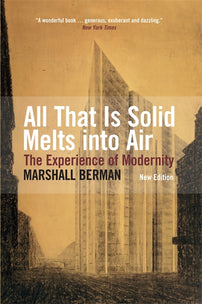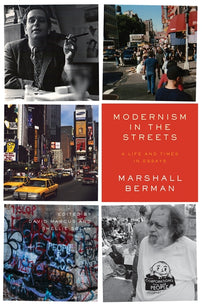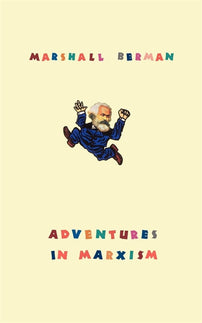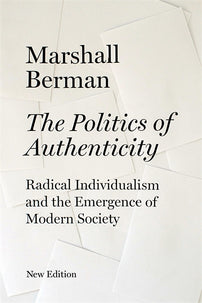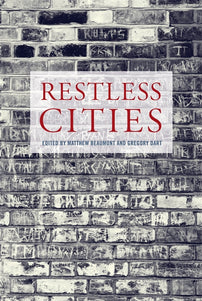'Soul-making in the throes of suffering'
Philosopher and Bronx native Marshall Berman is justly remembered for his pioneering work on the experience of urban modernity. Less well known is his writing on the development of hip-hop. Here, Philippe Le Goff writes on the place of rap in Berman's work, and how the world of the South Bronx helped give the music form.

Marshall Berman's account of the birth of hip-hop – and this will come as no surprise to those familiar with his work – begins with an anecdote. 'In the late seventies, at my school, City College of New York, during Club Hour on Thursday,' he recounts, 'somebody would bring out turntables, and a DJ would scratch and collage dozens of records together, while kids in the audience took turns playing MC, rapping over an open mike. (Some teachers rapped, too; I would have loved to, but I just couldn't rhyme.)'
Berman's writings on rap are underappreciated, perhaps even unknown. That he wrote about the genre, though, should be unsurprising. Across his books and essays he engages with a rich variety of popular culture (television, comic books, Hollywood blockbusters…). Popular music, too, appears regularly, and one can find discussions of and references to an eclectic mix of artists, from Bob Dylan and Cyndi Lauper to Stevie Wonder and the Sex Pistols, in his work. But rap spoke to Berman with a unique power and urgency, crystallising some of the most salient themes and concerns of his intellectual project.
Berman grew up in the South Bronx – the birthplace of hip-hop culture – in the 1940s and 1950s. He remembers his childhood neighbourhood as 'mostly working class and mostly Jewish', a place where 'life was mostly poor and hard'. During the post-war decades the South Bronx, that ‘shoddy but vibrant world’, became home to a richly diverse mix of immigrant communities – Irish, Italians, Puerto Ricans, African Americans, among others.
Wider forces also had a dramatic effect on the borough. In the early 1960s Robert Moses's Cross-Bronx Expressway cut it in two ('I would return from the Columbia library to the construction site and feel myself in the midst of the last act of Goethe's Faust' as Berman would write in his classic study of urban modernity, All That Is Solid Melts into Air). Berman's family left, along with thousands of others. The subsequent deindustrialisation and socio-economic crises of the 1970s hit the Bronx hard. Jobs vanished, municipal spending was slashed, public services were cut, poverty intensified. Then came the fires. Across the Bronx landlords torched buildings in order to claim insurance pay-outs. As Vivian Vázquez Irizarry and Gretchen Hildebran's excellent documentary Decade of Fire (2018) shows, redlining by the federal government and other discriminatory policies paved the way for the arson.
[book-strip index="1" style="buy"]The impact of the fires was devastating. Almost eighty per cent of the housing stock was destroyed; around a quarter of a million people were displaced. While New York City, in the grips of a fiscal crisis, teetered on the brink of bankruptcy, much of Berman's childhood neighbourhood was reduced to rubble. 'Dozens of blocks, blocks that for decades had been the densest and most crowded in the city,' he notes, 'now were suddenly as open as deserts.' The South Bronx became emblematic of urban decay: the archetypal inner city 'ghetto'. Years of systematic abandonment and neglect didn't usually figure in the narrative. For the predominantly Black and Hispanic residents who remained among what Berman describes as 'miles and miles of ruins', everyday life became a matter of trying the best they could to survive.
'At the very nadir of historical catastrophe,' Berman explains, 'rap was born.' The genre's original form bore the stamp of the conditions of its making. Created in the poorest congressional district in the United States, for Berman rap was 'an exemplary musica povera', 'made by kids who were too poor to afford instruments or lessons.' Here turntables, records, amps, boomboxes and microphones were the instruments, the means of self-expression. Among these kids in the Bronx were the early DJs – Kool Herc, Afrika Bambaattaa, Grandmaster Flash – whose manipulation of this equipment pioneered many of the sounds and techniques (scratching, needle dropping, looping…) that came to define hip-hop music.
[book-strip index="2" style="buy"]But it wasn't just music that was created amid destruction: all the constituent elements of hip-hop culture – graffiti, breakdancing, DJing, rapping – emerged within and against this context. Graffiti artists 'bombed' the ageing, greying subway system with vibrant tags and painted whole train cars with exuberant lettering ('I took my mother to the 149th Street subway stop, near where we have lived, with a good view of the trains. She was a very reserved woman, but she said, "It's a rainbow, in a place where who would expect one?"'), while breakdance crews combined power and flamboyance on their neighbourhood playgrounds and street corners. Areas that had been written off as 'unproductive', Berman observes, were the site of exhilarating cultural production. Young people across the community were transforming everyday city spaces – spaces that others had abandoned, spaces that others continued to overlook – bringing them to life, making them their own.
Berman really began to appreciate the immense richness of this musica povera in the early 1980s. Back then rap wasn't played on the radio. 'You had to go,' Berman explains, 'to be where it was happening'. This meant the college campus in Harlem, his place of work, or the South Bronx, his place of birth. Rap music was happening in the subways, on the sidewalks.
It was around this time that Berman completed All That Is Solid Melts into Air (1982). A line from Joyce's Ulysses, 'a shout in the street', provided a leitmotif for the book's exploration of the modern city street as a site and source of human possibility and cultural innovation. Berman traced various 'shouts in the street' across a century of modernist writing, from Baudelaire and Dostoevsky to Allen Ginsberg and Jane Jacobs. 'But I didn't produce much exciting street material from the years I was finishing the book, the late 1970s and early '80s,' he later reflected, 'and my narrative trails off at the end'. The material had been there all along, though. Hearing and seeing rap music on the streets of New York, Berman was 'thrilled' (a favourite word of his) by this new art form. A revelation, but also a confirmation: 'Rap knocked me out: I thought, All right, here it is, my shout in the street, I can hear.'
Rap's 'primal form' – 'a single black kid with a mike and a speaker that played a drum synthesizer track', as Berman describes it – was soon transposed into more elaborate forms. The advent of digital sampling in the mid-1980s enabled an evolution from raw, primitive backing tracks to complex, symphonic arrangements. So emerged in the late twentieth century 'the most creatively impure music ever made', an aesthetic of 'collage and montage' that 'appropriated every musical style in history: jazz, classical, folk, sacred, rock, soul, R&B, reggae, Broadway, Indian, African, along with background voices, street noises, and machines.'
But advances in production in the 1980s and 1990s, exhilarating and spectacular though the resulting sonic montages were, don't get to the heart of the genre. What really matters to Berman, what he delights in above all else, is the rapping itself: the lyrics, the delivery, the flow, the wordplay, the manipulation and 'stretching' of language so as 'to grasp and envelop reality'. 'What it meant for me was the power of the word, which was what I had been trying to teach all along.' The comic and the serious, the profane and the sacred, the personal and the political – it was all here, at once subtle and in your face. 'We have to listen to the words,' Berman says, 'and hear how they're being said, and imagine what they might mean, because a rapper's words have the power of life and death.'
Chuck D's lyricism is singled out for its force and sophistication. With records like 'Fight the Power' (1989) and 'Welcome to the Terrordome' (1990), he and Public Enemy 'helped a lot to expand rap's vocabulary'. Indeed for Berman they 'set a new standard in density and richness of sound, in lyrical brilliance, and in political seriousness and commitment'. References and allusions proliferated in rapping during this 'golden age' of hip-hop as it came to be known. Names like Machiavelli, Shakespeare and Nietzsche were being dropped alongside the likes of Reagan, Bush and Al Capone. And yet everything remained directly connected to daily life in Reagan's America as it was lived and experienced by marginalised and oppressed people and communities: its racism, police brutality, poverty, unemployment. At its best, rap seemed to Berman – and one could say the same of his own intellectual effort – to form a bridge between 'the stacks in the library and the signs on the street.'
Melle Mel arguably prepared the ground for much of this. Tracks such as 'Beat Street Breakdown' (1984) not only displayed impressive lyrical dexterity; his verses were 'powerful protest writing' that Berman places in the tradition of Big Bill Broonzy, Woody Guthrie, Bob Dylan and Bernice Reagon. Melle Mel's social and psychological insight is perhaps best heard on 'The Message' (1982) by Grandmaster Flash and the Furious Five, hip-hop's first hit record.
'The Message', in Berman's words, was 'heavy, dark and deep'. Gone were the frivolous and fun-loving rhymes and refrains that characterised early rap. Melle Mel and fellow MC Duke Bootee present a series of vignettes populated by piss and broken glass, rats and cockroaches, junkies and pimps, crime and violence. In the chorus, now a classic of American popular music, the narrator warns, 'Don't push me 'cause I'm close to the edge / I'm trying not to lose my head', before telling us, 'It's like a jungle sometimes it makes me wonder / How I keep from going under.'
With these lines, Grandmaster Flash and the Furious Five propelled rap music, and the everyday reality of the South Bronx, to a national and international audience. 'Suddenly a lot of people wanted to hear rap and thought it mattered.' As Berman explains, 'it opened up a genre that could channel the tidal flow of pain and rage that flooded American inner cities in the Reagan years of malign neglect.' So what was the message of 'The Message'? Here Berman's dialectical imagination takes hold. 'They are saying, We come from ruins, but we are not ruined.' It is a story of endurance, yet also of something more. 'The meta-message is something like this: Not only social disintegration, but even existential desperation, can be sources of life and creative energy.' (The Communist Manifesto, according to Berman's reading, contains a similar message.) 'The capacity for soul-making in the throes of suffering lit up the Bronx with an aura all its own.'
In his Phenomenology of Spirit, Berman notes, Hegel says that 'spirit is a power only by looking the negative in the face and living with it. Living with it is the magical power that converts the negative into being'. This, for Berman, is not only the message of the song but the meaning behind the birth of hip-hop as a whole. The kids from the Bronx 'are converting the negative into being. By affirming the ruins, they are making the rising possible.'
[book-strip index="3" style="display"]